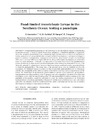Identificador persistente para citar o vincular este elemento:
https://accedacris.ulpgc.es/jspui/handle/10553/42076
| Título: | Food-limited invertebrate larvae in the Southern Ocean: testing a paradigm | Autores/as: | Ameneiro, Julia Lubián, L. M. Sangrà, Pablo Vázquez, E. |
Clasificación UNESCO: | 251007 Oceanografía física | Palabras clave: | Antarctica Brachiolaria Cryptophyceae Larval starvation Meroplankton, et al. |
Fecha de publicación: | 2016 | Publicación seriada: | Marine Ecology - Progress Series | Resumen: | A long-standing paradigm of larval ecology is that the high incidence of non-feeding larval development in Antarctic invertebrates is an adaptation to limited availability of algal food. Antarctic plankton communities have a relatively high diversity and abundance of invertebrate larvae, some of which are planktotrophic and synchronize the presence of feeding larval stages to peaks in summer phytoplankton. Among the echinoderm larvae found between 30 December 2002 and 7 January 2003 in the Bransfield Strait, the planktotrophic brachiolaria of Odontaster were the most abundant. Although phytoplankton is the main food source for planktotrophic larvae of asteroids in other oceans, previous estimates of the carbon requirements of larvae of the Antarctic asteroid O. validus have indicated that these larvae could not survive on natural levels of Antarctic phytoplankton. The main aims of the present study were to establish whether the abundance of Odontaster larvae is related to that of palatable phytoplankton and to determine whether the availability of the latter would be sufficient to cover the carbon requirements of the larvae. We found that of all palatable phytoplanktonic groups (Cryptophyceae, picoplankton, nanoplankton and ultraplankton), only Cryptophyceae was a significant predictor of brachiolaria abundance, along with the stratification index. We also found that the carbon content of the total palatable phytoplankton would be sufficient to meet the carbon requirements of Odontaster larvae at almost all stations and depths. Although O. validus spawns between mid- and late winter when the concentration of phytoplankton is lowest, winter spawning may be one way of meeting the exogenous energetic requirements of larvae. | URI: | https://accedacris.ulpgc.es/handle/10553/42076 | ISSN: | 0171-8630 | DOI: | 10.3354/meps11786 | Fuente: | Marine Ecology Progress Series [ISSN 0171-8630], v. 554, p. 71-80 |
| Colección: | Artículos |
Citas SCOPUSTM
1
actualizado el 08-jun-2025
Citas de WEB OF SCIENCETM
Citations
1
actualizado el 08-jun-2025
Visitas
70
actualizado el 27-jul-2024
Descargas
105
actualizado el 27-jul-2024
Google ScholarTM
Verifica
Altmetric
Comparte
Exporta metadatos
Los elementos en ULPGC accedaCRIS están protegidos por derechos de autor con todos los derechos reservados, a menos que se indique lo contrario.
